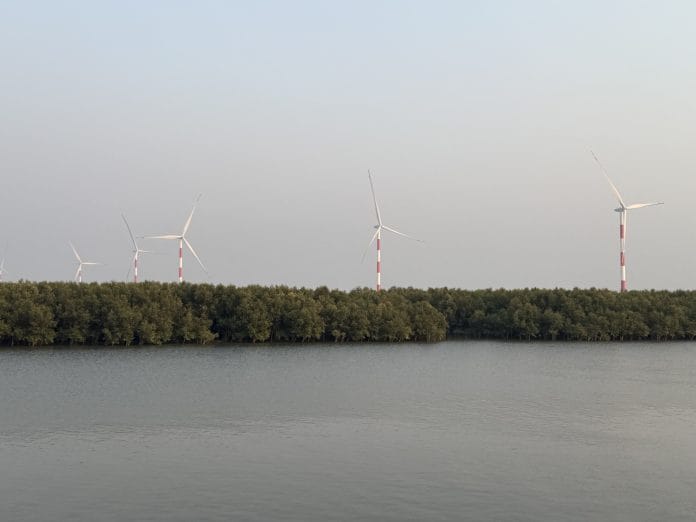–Md Ibrahim Khalilullah, Climate Storyteller at CNN Academy, writes articles for Just Energy News:
Abdul Haque sits cross-legged in the courtyard of his home in Chakaria, Cox’s Bazar, watching a massive turbine turn slowly against the morning sky. The chill of winter has faded, and the sun climbs steadily. At 52, Haque still supports his family of seven through fishing and farming.
Last year, a 60 MW wind power plant began operations nearby – Bangladesh’s largest to date. For Haque, who has lived in the region all his life, seeing electricity generated from wind, not diesel or gas, still feels surreal.
“I couldn’t believe that such big fans on such big pillars can turn and generate current,” he says, eyes wide. “No engine is needed, just the wind. How much the world has changed.”
But wonder quickly gives way to frustration. For millions like him, electricity is still unreliable.
“Sometimes there’s power, sometimes not,” he shrugs. “You don’t know when it will cut or come back. It goes out for hours.”
Tanbirul Miraj Ripon, an independent journalist from Cox’s Bazar, feels the same. “Land providers and locals are getting interrupted electricity supplies. It’s a discriminatory electric distribution system.”
Millions in Bangladesh experience inconsistent electricity supply — especially in rural and coastal areas, where outages can last for hours each day. According to the Power System Master Plan, the country aims to generate 38,600 MW by 2030 and 50,000 MW by 2041 to sustain economic growth above 7 per cent.
There are two ways to meet this demand: continue spending billions on fossil fuel imports like oil and coal — or unlock the vast renewable energy potential that surrounds Bangladesh. Wind energy, in particular, offers an untapped opportunity. But despite clear promise, the country’s wind sector remains stuck in early stages.
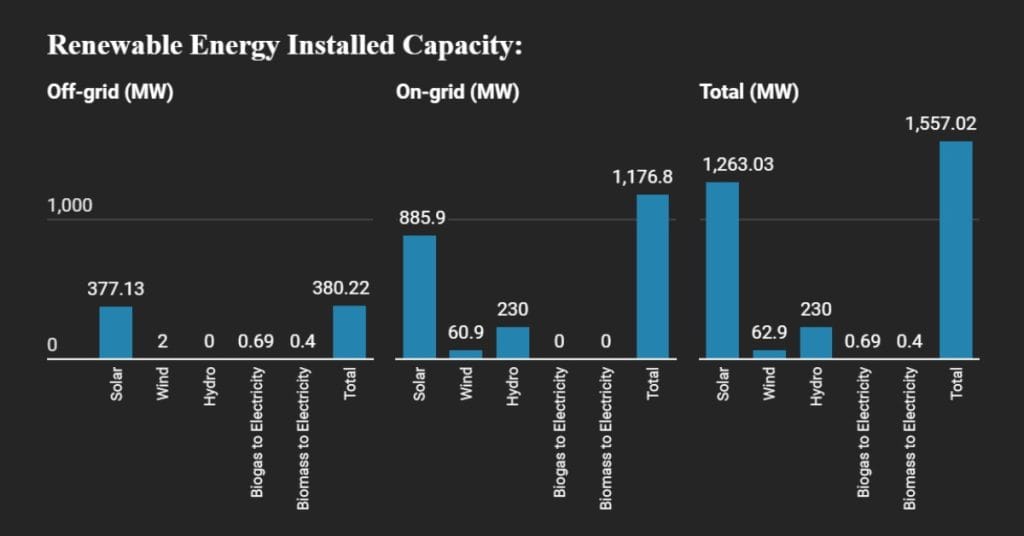
Source: (SREDA, 2025).
Bangladesh’s enormous wind potential
As of early 2025, wind power makes up just 0.67% of Bangladesh’s total installed energy capacity — about 62.9 MW. Most of that comes from three early pilot projects: a 900 KW turbine in Feni and two 1 MW wind-battery hybrid plants on Kutubdia Island.
By comparison, solar has already crossed 1,260 MW, and hydropower adds another 230 MW. Wind remains the smallest player in the renewables mix.
Yet the potential is enormous. A 2018 study by the National Renewable Energy Laboratory (NREL) estimated Bangladesh could support up to 30 GW of wind capacity — evenly split between onshore and offshore — especially in coastal areas like Cox’s Bazar, Bhola, and Patenga where average wind speeds hover between 6–7 m/s, suitable for modern turbines.
“There is a huge potential for wind energy in the coastal area,” says M Zakir Hossain Khan, managing director of the research group Change Initiative.
“The government can take up at least 3,000 MW wind power generation projects by 2027 with foreign investment… but immediate substation facilities must be ensured. Otherwise, investment costs will rise.”
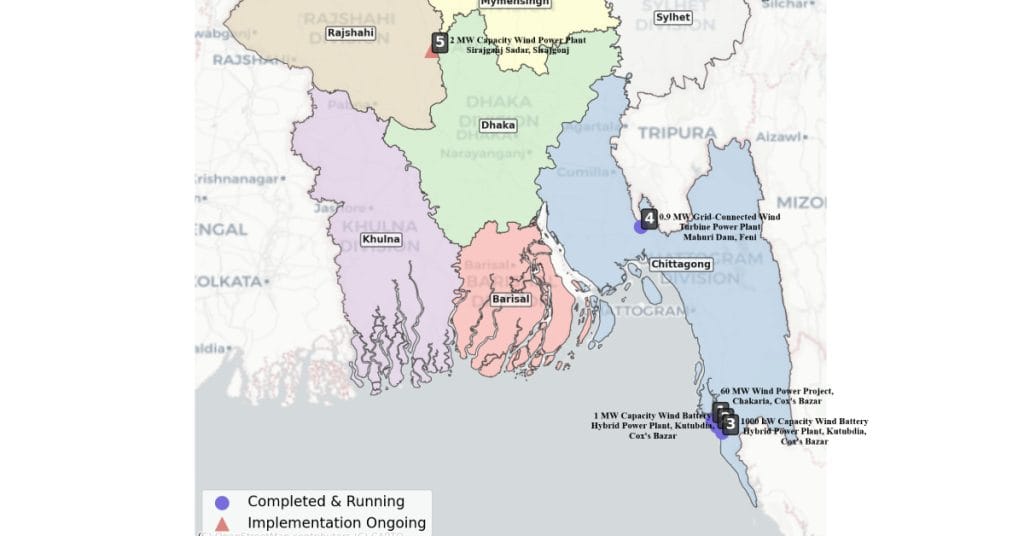
Source: SREDA’s National Database
Big Plans, Slow Progress
The 60 MW plant in Chakaria that Haque watches is currently the country’s largest operational wind project. Developed by US-DK Green Energy (BD) Ltd under an Independent Power Producer (IPP) agreement with the Bangladesh Power Development Board (BPDB), it began generating power in March 2024.
Other operational projects include:
- Two 1 MW hybrid plants on Kutubdia Island (2008 and 2015), supplying off-grid power
- A 900 KW turbine at Mahuri Dam in Feni, connected to the grid since 2006
Together, these total 63.9 MW — a fraction of the country’s 25,514 MW total generation capacity.
One more project — a 2 MW wind plant in Sirajganj — remains under construction after missing its original 2022 completion date.
Meanwhile, 10 additional wind projects totalling 665 MW are in various planning stages. Cox’s Bazar alone accounts for 430 MW. But many are delayed or stuck in feasibility stages, highlighting the disconnect between ambition and execution.
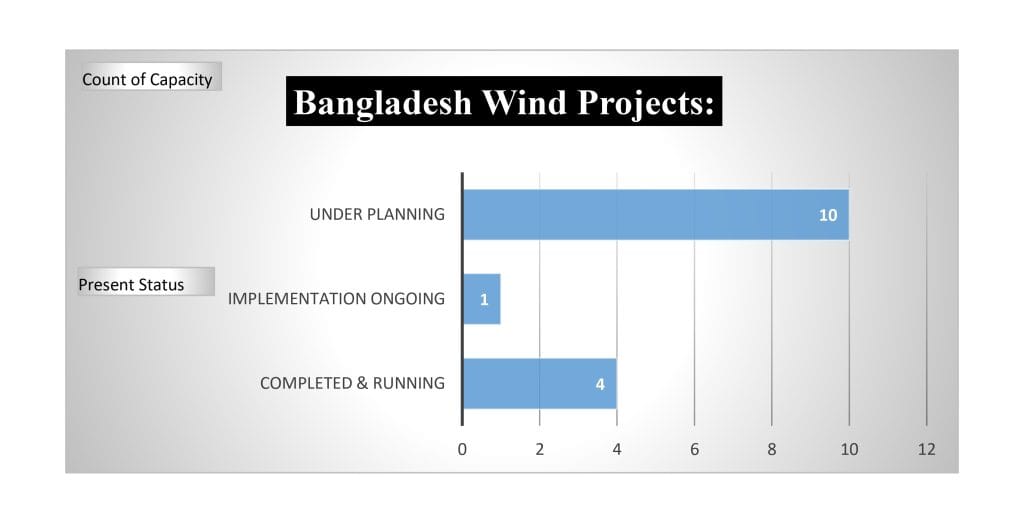
Source: SREDA’s National Database
Barriers to the Breeze
Wind may be free, but harnessing it isn’t. Bangladesh’s wind transition faces technical, economic, and bureaucratic hurdles.
Turbines must be cyclone-resistant — which increases upfront costs by 20–30%. At the same time, the national grid is not designed to handle the variability of wind. With urban areas already facing 3–5-hour daily outages and 14% transmission losses (World Bank, 2022), integrating large-scale wind power is a challenge.
“Bureaucratic complexity is a real crisis,” says Hasan Mehedi, chief executive of CLEAN, an NGO working on environmental access.
“If government officials are sincere, development work moves quickly. The authorities must not neglect wind power’s potential. There’s no other option but to take it seriously.”
The financial challenges are just as steep. Offshore wind projects can cost $3–4 million per MW, double the cost of onshore turbines. According to government estimates, Bangladesh faces a $70 billion energy financing gap by 2035.
“To grow wind, foreign investment is essential. We need an exclusive budget,” says Zakir Hossain Khan.
“There are many plans. Now it’s time to implement them.”
The Cost of Catching the Wind
Foreign interest is growing. Denmark’s Copenhagen Infrastructure Partners has proposed a 500 MW offshore project in the Bay of Bengal. U.S. companies are eyeing Bangladesh’s coastal potential, helped by tax incentives.
But policy instability, regulatory opacity, and economic uncertainty — including currency reserves strained by fossil fuel imports — continue to deter investors.
“To attract wind investment, Bangladesh must use tools like green bonds, PPPs, and feed-in tariffs,” says Anjal Prakash, professor at the Indian School of Business and IPCC author.
“Long-term revenue certainty is essential. Streamlined permits and power purchase agreements can help.”
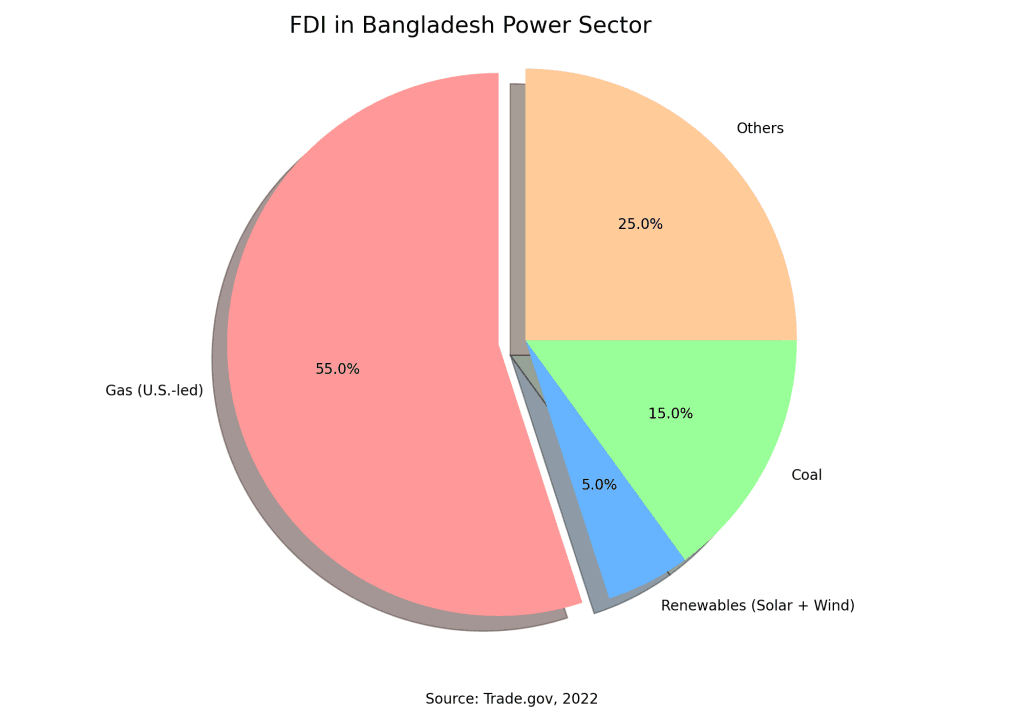
Lesson from Next Door
In South Asia, Bangladesh lags far behind. India generates 8% of its electricity from wind, with 48 GW of capacity — mostly in Gujarat and Tamil Nadu. Pakistan has 1.8 GW, primarily from its Sindh wind corridor — 12 times more than Bangladesh.
“India’s wind expansion was built on smart public incentives and clear policies,” says Harjeet Singh, climate activist and founding director of Satat Sampada Climate Foundation.
“They used feed-in tariffs, viability gap funding, and concessional loans to de-risk investment. Bangladesh must do the same.”
Singh recommends wind-specific targets, Renewable Purchase Obligations (RPOs), and tax holidays to make wind attractive.
“Transparent procurement and strong grid integration are essential,” he says. “Without it, wind power will stay stuck at the margins.”
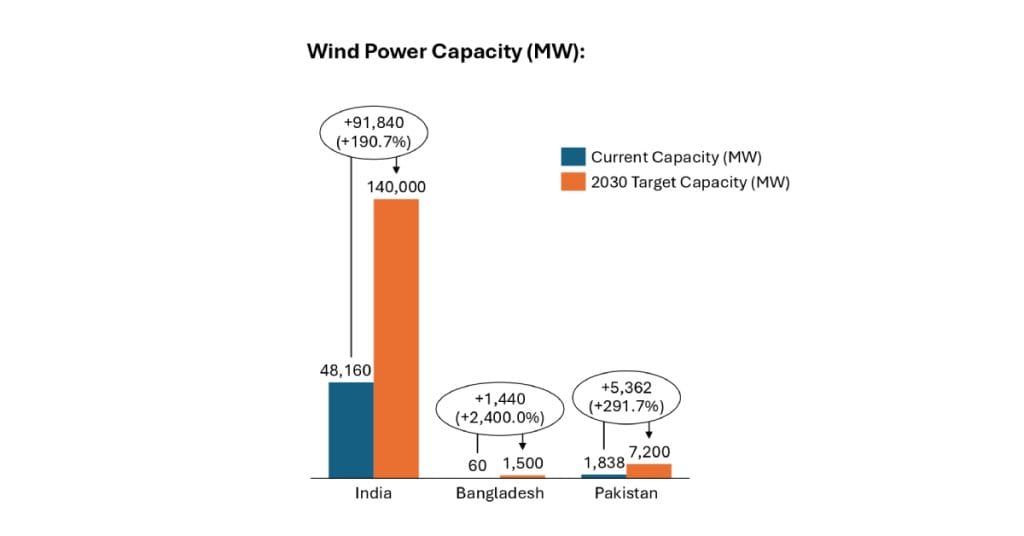
Sources: MNRE, AEDB, NREL
The Clock Is Ticking on Wind Power
Bangladesh may be behind — but it holds a powerful advantage. Its V-shaped coastline funnels strong monsoon winds, giving offshore turbines 40–50% more output than inland ones. According to IRENA, the Bay of Bengal holds 30 GW of wind potential — more than what Pakistan’s land-based farms offer and on par with India’s offshore vision.
With Bangladesh ranked 7th on the Global Climate Risk Index, wind energy isn’t just about sustainability — it’s about survival.
“If the government and relevant authorities don’t act seriously now,” warns Zakir,
“Bangladesh will fail miserably to meet its renewable energy targets.”
“Now is the most important time to act,” echoes Mehedi.
“Otherwise, Bangladesh will face not just energy shortages, but global pressure.”
Experts say the government must finalise its National Wind Energy Roadmap, set specific targets, and introduce developer-friendly policies tailored to wind — not just broad renewables.
“For Bangladesh, balancing wind energy development against its reliance on fossil fuels could lead to energy diversification and environmental benefits,” says Professor Anjal Prakash.
“Bangladesh needs to decrease the cost of wind power significantly to become more competitive with fossil fuels such as natural gas and coal.”
(You can reach the journalist at [email protected])

